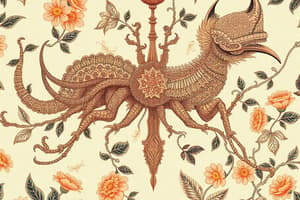Podcast
Questions and Answers
What does phylogeny primarily represent?
What does phylogeny primarily represent?
- The evolutionary history of a species or group of species (correct)
- The reproductive habits of organisms
- The behavior patterns of animals in their habitat
- The geographical distribution of species
What is a characteristic of homologous structures?
What is a characteristic of homologous structures?
- They always serve the same function in all organisms.
- They exhibit variations due to their shared ancestry. (correct)
- They look and function the same across different species.
- They are formed through convergent evolution.
Which of the following is an example of comparative embryology?
Which of the following is an example of comparative embryology?
- The observation of post-anal tails in vertebrate embryos (correct)
- The study of marine fossils
- Analyzing feeding habits of different lizard species
- Examining the coloration patterns of adult animals
How are vestigial structures defined?
How are vestigial structures defined?
What type of evidence can be used to infer phylogeny?
What type of evidence can be used to infer phylogeny?
What do molecular homologies indicate?
What do molecular homologies indicate?
Which of the following statements about morphological homologies is true?
Which of the following statements about morphological homologies is true?
Flashcards are hidden until you start studying
Study Notes
Phylogeny and Evolutionary Relationships
- Phylogeny refers to the evolutionary history of a species or group of species.
- It illustrates the evolutionary relationships among individuals, such as the distinction between legless lizards and snakes evolving from different lineages of legged lizards.
Methods of Inferring Phylogeny
- Phylogeny can be inferred from various sources:
- Fossil records provide historical evidence of species and their changes over time.
- Morphological homologies highlight structural similarities across species due to shared ancestry.
- Molecular homologies investigate genetic similarities that stem from common ancestors.
Homologies and Their Significance
- Homologies are similarities resulting from shared ancestry, important for understanding evolutionary connections.
- Homologous structures exhibit fundamental similarities due to common ancestry, despite differing appearances and functions in various species, such as bat wings and whale limbs.
Morphology and Relatedness
- Organisms sharing similar morphologies are often closely related in an evolutionary context.
- Homologous structures indicate anatomical resemblances that represent variations of a common structural theme inherited from ancestors.
Comparative Embryology
- Comparative embryology uncovers anatomical homologies that may not be visible in adult organisms.
- All vertebrate embryos exhibit a post-anal tail and pharyngeal arches, highlighting common developmental features among species.
Vestigial Structures and Molecular Evidence
- Vestigial structures are remnants of features that once served a function in ancestral organisms but are now reduced or nonfunctional.
- Molecular homologies include genes shared among organisms, indicating traits inherited from a common ancestor, reinforcing the idea of evolutionary relationships.
Studying That Suits You
Use AI to generate personalized quizzes and flashcards to suit your learning preferences.




